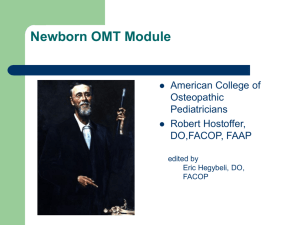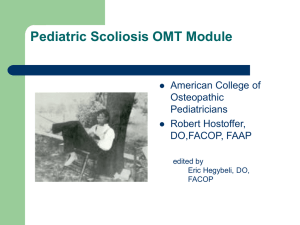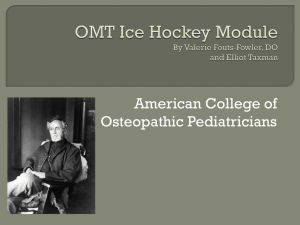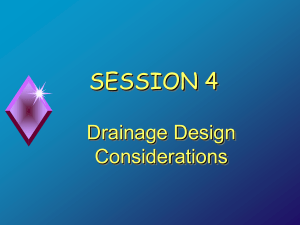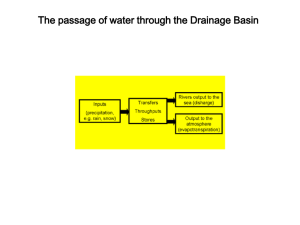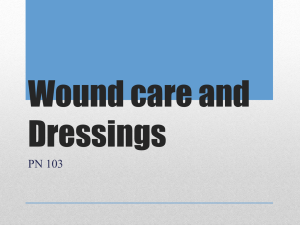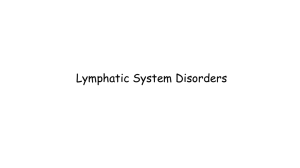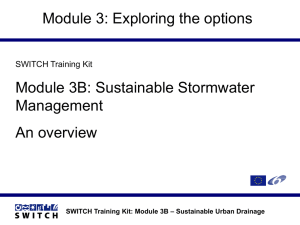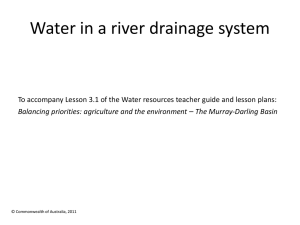Pediatric Sinus Drainage OMT Module
advertisement
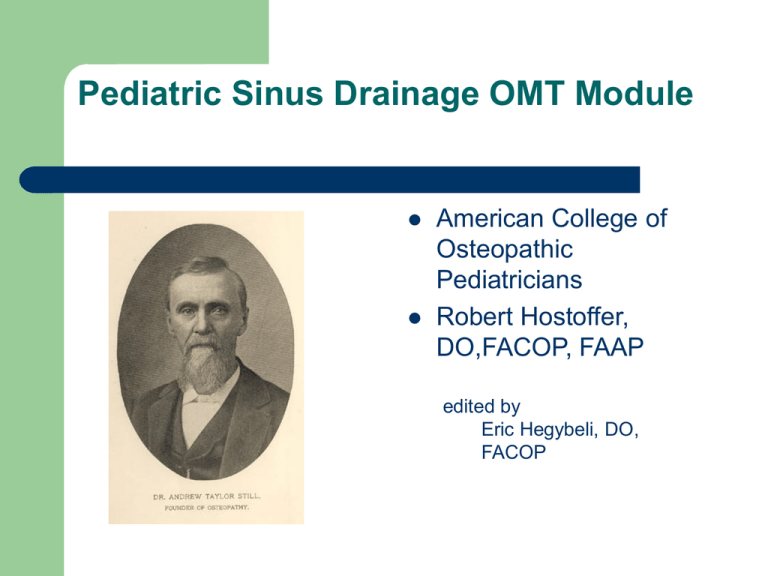
Pediatric Sinus Drainage OMT Module American College of Osteopathic Pediatricians Robert Hostoffer, DO,FACOP, FAAP edited by Eric Hegybeli, DO, FACOP Background: Andrew Taylor Still, was born in Virginia in 1828, the son of a Methodist minister and physician. At an early age, Still decided to follow in his father's footsteps as a physician. After studying medicine and serving an apprenticeship under his father, Still became a licensed M.D. in the state of Missouri. Later, in the early 1860's, he completed additional coursework at the College of Physicians and Surgeons in Kansas City, Missouri. He went on to serve as a surgeon in the Union Army during the Civil War. Background: After the Civil War and following the death of three of his children from spinal meningitis in 1864, Still concluded that the orthodox medical practices of his day were frequently ineffective, and sometimes harmful. He devoted the next ten years of his life to studying the human body and finding better ways to treat disease. Background: His research and clinical observations led him to believe that the musculoskeletal system played a vital role in health and disease and that the body contained all of the elements needed to maintain health, if properly stimulated. Still believed that by correcting problems in the body's structure, through the use of manual techniques now known as osteopathic manipulative treatment, the body's ability to function and to heal itself could be greatly improved. He also promoted the idea of preventive medicine and endorsed the philosophy that physicians should focus on treating the whole patient, rather than just the disease. http://www.aacom.org/OM/history.html Toddler and Children OMT Review Sinus Anatomy Review Anatomy of Ear Respiratory System: Otitis Media Goals & Considerations – Encourage proper Eustachian tube mechanics – Tube positioning Promote drainage of the middle ear via lymphatic channels Central drainage Acute Otitis Media (AOM) – The use of osteopathic manipulative treatment as adjuvant therapy in children with recurrent acute otitis media. Mills MV, Henley CE, Barnes LL, Carreiro JE, Degenhardt BF. Arch Pediatr Adolesc Med. 2003 Sep;157(9):861-6. Eustachian tube difference Hands-On Approach Treating Otitis Media Treatment Options – – – – – – – – Thoracic Muscular Assessment and Treatment Thoracic Inlet/Outlet Release (emphasizing the right side, which drains the entire head and neck) Occipitoatlantal (OA) Release Rib Raising (T1-4) Chapman’s Points Auricular Drainage Technique Mandibular Drainage of Galbreath Miller Thoracic Pump Contraindications: Rib fracture and dislocation, malignancy of lymphatic system Relative Contraindications: Decreased cough reflex Respiratory System: Pharyngitis Goals & Considerations – – – – – Improve venous and lymphatic drainage Promote arterial blood flow Normalize cranial and spinal nerve afferents and efferents affecting function of the throat* Relieve pain * It is important to note that most of the cranial nerves which innervate the pharynx pass through the suboccipital area Hands-On Approach Treating Pharyngitis Treatment Options – – – – – – – Cervical & Thoracic Muscular Assessment and Treatment Thoracic Inlet/Outlet Release OA Release Rib Raising (T1-4) Chapman’s Points Cervical Chain Drainage Miller Thoracic Pump Contraindications: Rib fracture and dislocation, malignancy of lymphatic system Relative Contraindications: Decreased cough reflex Hands-on Sinus Drainage Techniques Sinus Effleurage To effleurage is to move in a stroking massage movement to move lymphatic fluids. Excessive mucus production, and decrease of cilliary motility can all be modified using effleurage. Effleurage will promote lymphatic drainage in both allergic or infective pathology. Effleurage of the anterior cervical chain towards each lymphatic duct and ultimately the heart will eventually promote health. Positioning The patient is supine. With repetitive strokes, the thumbs are brought across the frontal maxillary sinuses from medial to lateral finishing at a point near the ear lobes. The thumbs should be used to milk the lymphatic fluid down the anterior aspect of the sternocleidomastoid muscle belly along the anterior cervical lymphatic chain towards the heart. Repeat this technique for complete drainage. Demonstrate the procedure on patient in front of director Demonstrate the procedure on patient in front of director Demonstrate the procedure on patient in front of director Demonstrate the procedure on patient in front of director Mandibular Drainage of Galbreath A passive soft tissue technique is used to induce jaw motion to create increased drainage of middle ear and tonsillar areas via the eustachian tube and lymphatics. This technique can be used for chronic otitis media. Positioning The patient is supine and the dcotor is behind patient, while stabilizing the head and placing traction on the mandible. With a “pumping action,” the fascia of the eustachian tube via the mandible is brought anteriorly and medially across the face a short distance, multiple times on each side of the head. The procedure is done for 30 seconds on each side for up to three times a day. Demonstrate the procedure on patient in front of director Ear Pull Technique A gentle bilateral ear pull will help mobilize the underlying fascia and the temporal bones. The physician will notice that one side may be less mobile and may require longer to feel a release. The side that is more medial often correlates with an internally rotated temporal bone. Positioning The patient is supine. The doctor is behind the patient. A gentle force is applied to the bilateral pinnae until the pinnae becomes more mobile. The earpull is helpful in infants but may not be useful in children that are moving around. Demonstrate the procedure on patient in front of director Chapman’s Reflexes Discovered by Frank Chapman, D.O., – – Chapman's Reflexes are painful palpated points located all over the body. These reflexes are clinically useful in three principal ways: 1) for diagnosis, 2) for influencing the motion of fluids, mostly lymph, and 3) for influencing visceral (organ) function through the nervous system. Innervation Table Organ/System EENT Parasympathetic Sympathetic Ant. Chapman's Post. Chapman's T1-T4 T1-4, 2nd ICS Suboccipital Heart Cr Nerves (III, VII, IX, X) Vagus (CN X) T1-T4 T3 sp process Respiratory Vagus (CN X) T2-T7 T1-4 on L, T2-3 3rd & 4th ICS Esophagus Vagus (CN X) T2-T8 --- T3-5 sp process --- Foregut Vagus (CN X) T5-T9 (Greater Splanchnic) --- --- Stomach Vagus (CN X) T5-T9 (Greater Splanchnic) Liver Vagus (CN X) Gallbladder T6-7 on L T5-T9 (Greater Splanchnic) 5th-6th ICS on L Rib 5 on R Vagus (CN X) T5-T9 (Greater Splanchnic) Rib 6 on R T6 Spleen Vagus (CN X) T5-T9 (Greater Splanchnic) Rib 7 on L T7 Pancreas Vagus (CN X) Rib 7 on R T7 Midgut Vagus (CN X) T5-T9 (Greater Splanchnic), T9T12 (Lesser Splanchnic) Thoracic Splanchnics (Lesser) Small Intestine Vagus (CN X) T9-T11 (Lesser Splanchnic) Ribs 9-11 T8-10 Tip of 12th Rib T11-12 on R Appendix Hindgut Ascending Colon Transverse Colon T12 Pelvic Splanchnics (S24) Vagus (CN X) Vagus (CN X) Lumbar (Least) Splanchnics T9-T11 (Lesser Splanchnic) T5-6 --- --- --- --T10-11 T9-T11 (Lesser Splanchnic) R Femur @ hip Near Knees L Femur @ hip T12-L2 Descending Colon Pelvic Splanchnic (S2-4) Least Splanchnic Colon & Rectum Pelvic Splanchnics (S24) T8-L2 --- --- --- Print out the answer sheet to use with the following questions. Circle the correct answer and review with director: Question1: A, B, C, D, E. Question2: A, B, C, D, E. Question3: A, B, C, D, E. Post Test A 2 day old male is seen in the newborn nursery for initial examination. The nurses note that the newborn is having difficulty nursing and latching onto mother’s nipple. Which procedure would be the most appropriate for this patient: – – – – – A. Ear pull tugging B. Mandibular Drainage of Galbreath C. Occipital release D. Sinus Effleurage E. Maxillary release A 2 year old male presents for chronic otitis media with effusions. At the present visit he has no active infection but as bilateral effusions. Which procedure would be most appropriate: – – – – – A. Occipital-temporal release B. Cervical HVLA C. Mandibular Drainage of Galbreath D. Cranio-sacral maneuvers E. Sinus Effleurage A 18 year old female presents to your office with pressure and pain over the face. The patient is afebrile without evidence of infection. These symptoms have been present for 2 years and worsens with change of seasons. The most appropriate osteopathic treatment would be: – – – – – A. Mandibular drainage of Galbreath B. Ear pull tugging C. Sinus Effleurage D. HVLA to the thorax E. Occipital release Certificate of Completion I, _________________________, successfully completed the Pediatric OMT Module on __ __ 20__ Signatures: Pediatric Resident ____________________ Pediatric Residency Director____________ ( Please print and give to program director.) Congratulations
